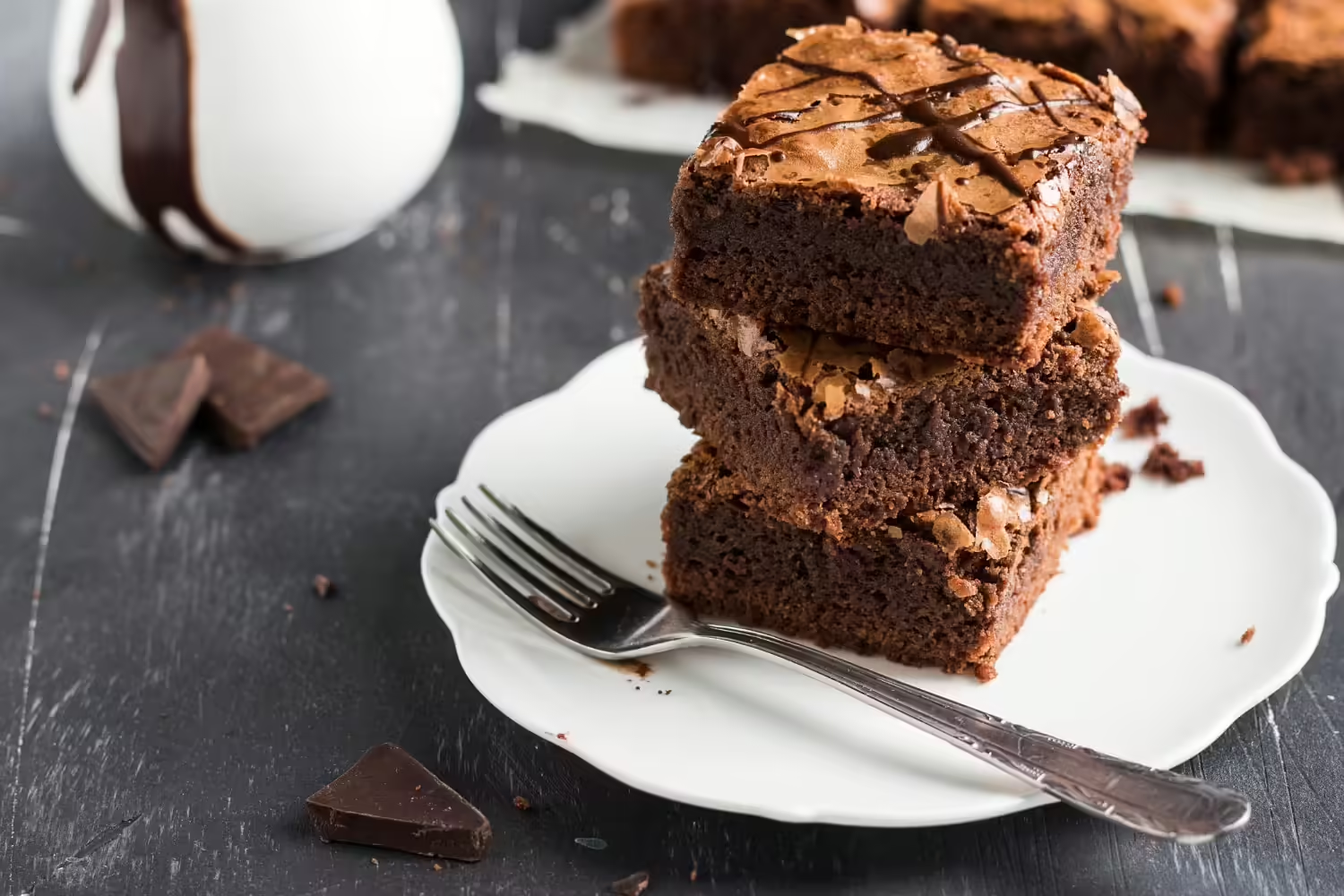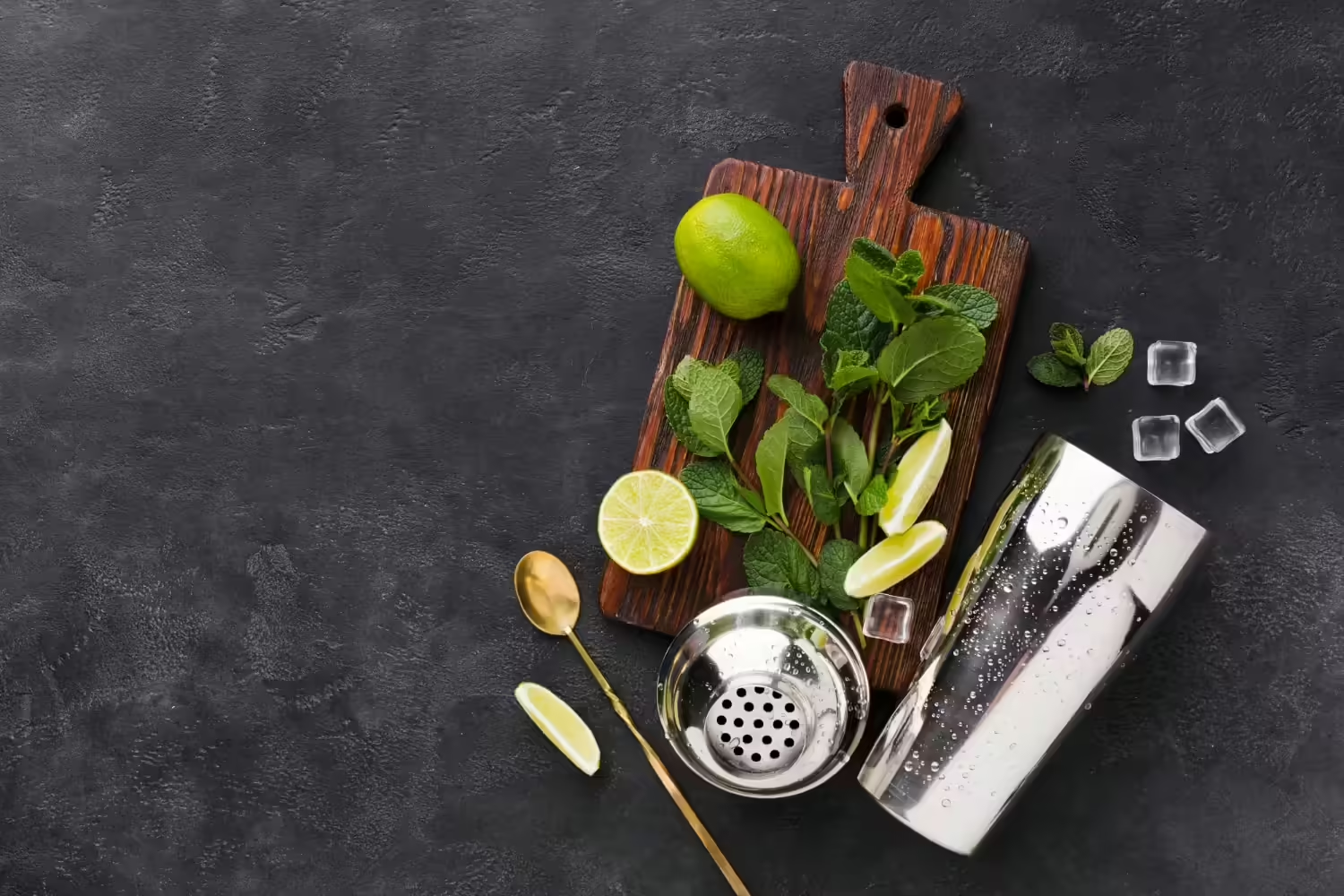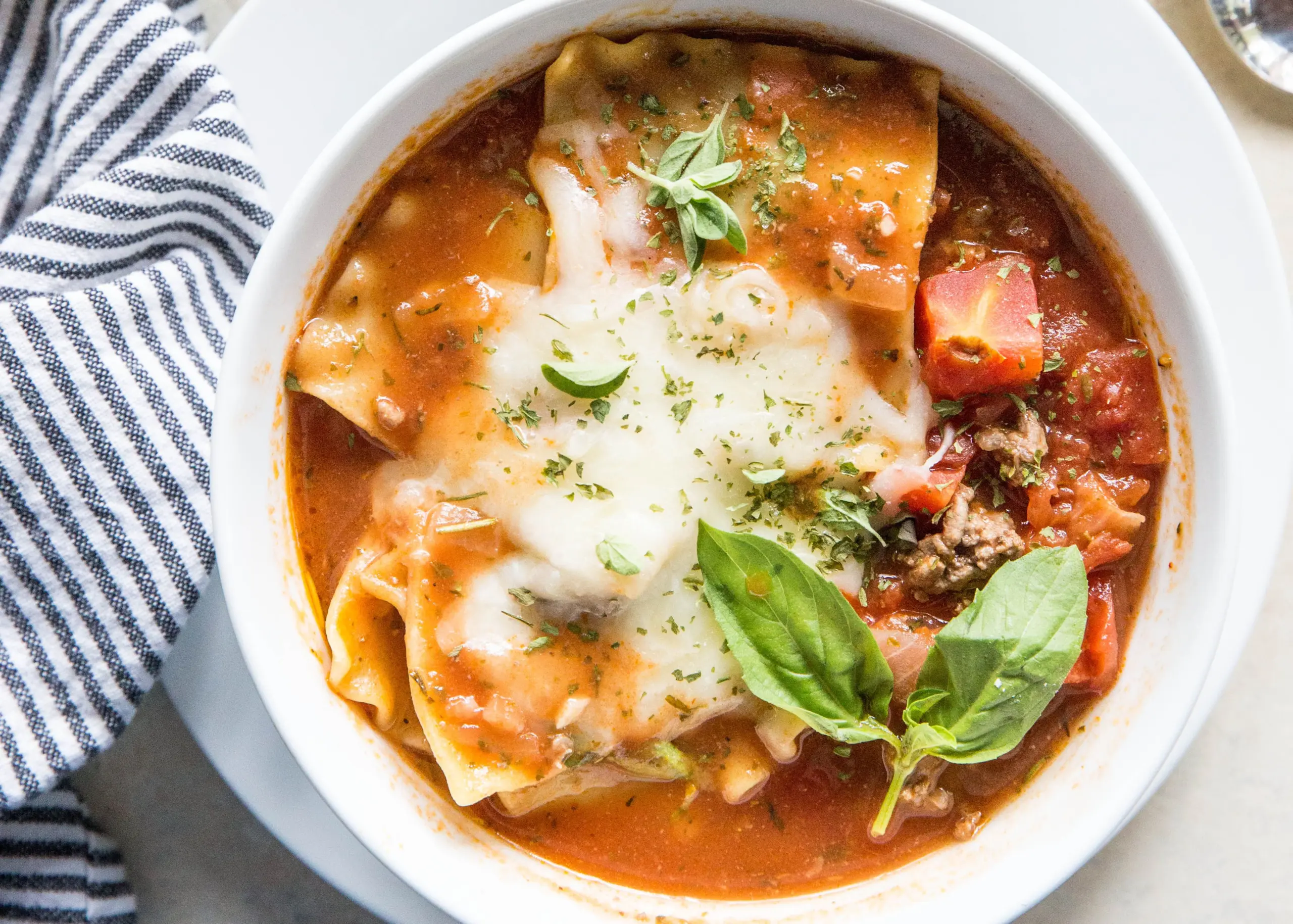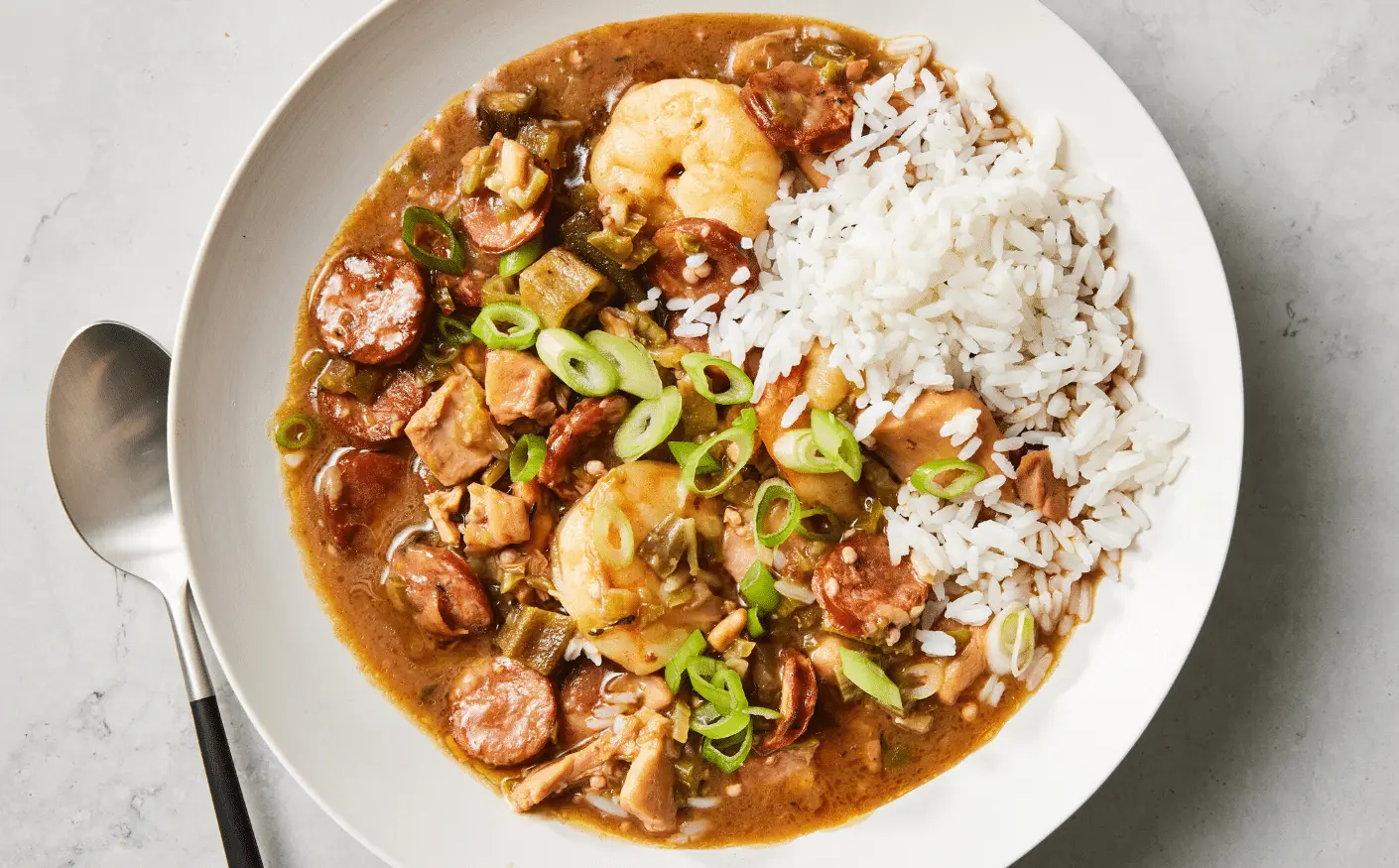
Gumbo stands as a culinary emblem of the rich cultural tapestry of Louisiana, blending French, Spanish, West African, and Native American influences into a hearty, comforting stew. This dish, deeply rooted in the Creole and Cajun traditions, varies widely in its ingredients and preparation methods, reflecting the diverse heritage of the region. Whether it’s the robust, seafood-laden Creole gumbo from the cosmopolitan streets of New Orleans or the spicier, rustic Cajun version from the rural parts of Louisiana, each bowl tells a story of cultural convergence and culinary innovation.
Central to every gumbo recipe is the “Holy Trinity” of celery, onions, and green peppers, paired with a base of thick roux and a variety of proteins like chicken, sausage, or seafood. Cajun spices enhance the complexity of gumbo’s flavors, and chefs sometimes thicken it with gumbo file powder, a traditional ingredient made from sassafras leaves. The cooking process itself is a ritual, passed down through generations, symbolizing family, community, and the history of gumbo itself.

Table of contents
Key Ingredients of Gumbo
Every bowl of gumbo starts with a foundation built on key ingredients that are quintessential to achieving its distinctive, deeply flavorful profile. Central to these ingredients is the “Holy Trinity” of Cajun and Creole cooking, a term that refers to the indispensable trio of celery, onions, and green peppers. This mirepoix provides a savory base that enhances the complexity of the gumbo’s flavors.
Roux, a thickening agent made from equal parts fat and flour, is another cornerstone of gumbo. Its color, ranging from light blonde to deep chocolate brown, determines the depth of flavor in the dish. Cooking the roux requires patience and constant stirring to achieve the perfect color and consistency without burning. The roux’s role is crucial as it thickens the gumbo, giving it the iconic silky texture that it’s known for.
Proteins vary widely in gumbo, reflecting both availability and personal preference. Typical selections include andouille sausage, which adds a smoky, spicy kick, and various forms of seafood like shrimp or crabmeat, contributing to the gumbo’s hearty and fulfilling nature. Chicken is another popular choice, often used in combination with sausage to balance the flavors.
Spices play a pivotal role in gumbo, with Cajun seasoning bringing heat and complexity through ingredients like paprika, cayenne, garlic powder, and thyme. Each cook has their own blend, making each gumbo recipe unique. Additionally, chefs often sprinkle gumbo file powder, made from dried sassafras leaves, on top as a finishing spice, adding an earthy note and aiding in the thickening process.
Step-by-Step Gumbo Recipe
Creating a pot of gumbo is like conducting an orchestra; every ingredient must come in at the right time and harmonize perfectly with the others. Here’s a detailed, step-by-step guide to making an authentic gumbo, loaded with flavor and tradition.
Preparing the Roux
- Start with the roux: The foundation of any gumbo is its roux, which is a mixture of flour and fat cooked together until it reaches the desired color. For gumbo, you want a dark roux, which will impart a rich, deep flavor and a chocolate-brown color. Melt about a cup of fat (can be butter, oil, or animal fat) in a heavy pot over medium heat. Gradually add an equal amount of flour, stirring constantly with a wooden spoon. The process can take about 15 to 20 minutes; the key is to stir constantly to prevent burning.
- Achieve the perfect color: As the roux cooks, it will slowly darken. For a traditional gumbo, aim for a color similar to dark peanut butter or a Hershey’s milk chocolate bar. This stage is crucial as the darker the roux, the more complex the flavors will be.
Building the Base
- Add the Holy Trinity: Once the roux reaches the desired color, quickly add the “Holy Trinity” of Cajun cooking—chopped onions, celery, and green bell peppers. This will stop the roux from cooking further and burning. Sauté the vegetables in the roux until they soften, about 5 minutes.
- Incorporate the proteins: Add your chosen proteins to the pot. Popular options include andouille sausage, cut into slices, and chicken pieces. Brown the meats slightly with the vegetables and roux to enhance their flavors.
- Pour in liquids and seasonings: Gradually stir in about 6 cups of chicken stock, scraping the bottom of the pot to lift the roux and incorporate it into the liquid. Add Cajun spices to taste—typically a blend of garlic powder, cayenne, paprika, and thyme. You can also add a couple of bay leaves for additional flavor.
Simmering the Gumbo
- Let it simmer: Bring the gumbo to a boil, then reduce the heat and let it simmer uncovered for at least 45 minutes. This slow cooking process helps the flavors meld together and the gumbo to thicken naturally.
- Add seafood and okra: If you’re making a seafood gumbo, add the seafood (shrimp, crabmeat, oysters) and sliced okra about 10 minutes before the gumbo is finished cooking. The okra not only adds flavor but also acts as a thickener.
- Season with gumbo file: Towards the end of cooking, sprinkle in gumbo file powder (ground sassafras leaves). This will add an earthy flavor and further thicken the gumbo. Stir well and cook for an additional 5 minutes.
Final Touches and Serving
- Adjust seasoning: Taste your gumbo and adjust the seasoning with salt, pepper, and more Cajun spices if needed. Some like to add a dash of hot sauce for an extra kick.
- Serve over rice: Servers traditionally present gumbo over a scoop of white rice, which balances the rich flavors and adds a comforting texture.
- Garnish and enjoy: Garnish with chopped green onions or parsley before serving to add a fresh touch to your hearty dish.
Making gumbo can be a day-long affair, especially if you take the time to let the flavors develop fully. It’s a labor of love, but the result is a comforting, flavorful dish that’s steeped in Louisiana tradition.
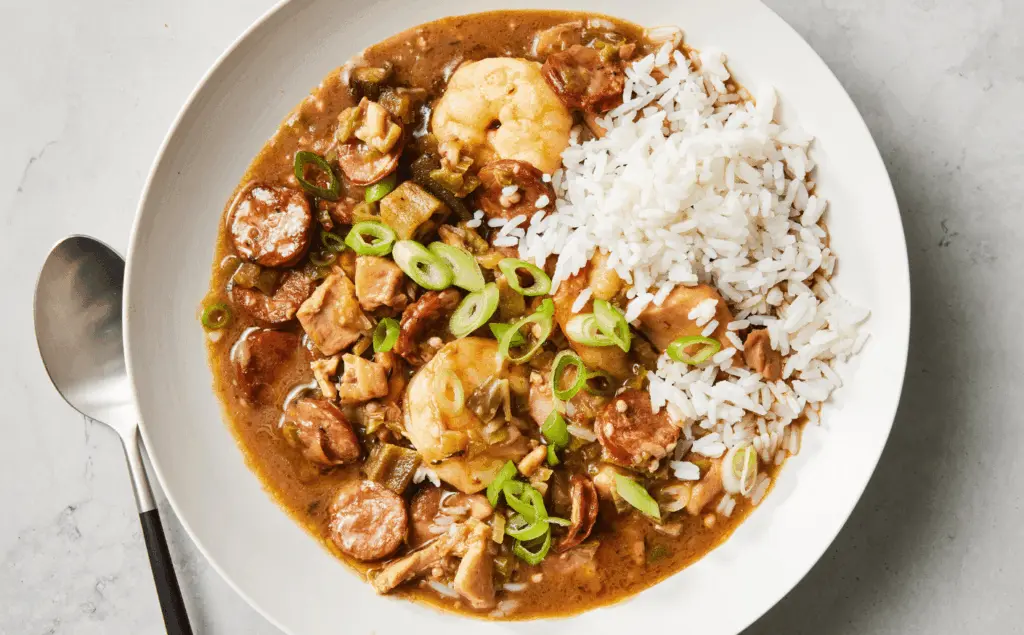
Variations of Gumbo
Gumbo is a versatile dish that reflects the diverse culture of Louisiana, accommodating a wide range of tastes and preferences. While the traditional recipes for seafood or chicken and sausage gumbo are widely beloved, numerous variations offer delightful twists on the classic. Here, we explore some of the popular alternatives that cater to different dietary needs and flavor profiles.
Seafood Gumbo
Seafood gumbo is a favorite during the Lenten season and for those who prefer the flavors of the ocean. Typically loaded with shrimp, crabmeat, and sometimes oysters, this version emphasizes the fresh, briny tastes of the Gulf. Seafood gumbo often features a lighter roux, maintaining a balance that allows the delicate seafood flavors to shine through. The addition of file powder is crucial as it complements the seafood with its earthy tones.
Chicken and Sausage Gumbo
A hearty choice for meat lovers, chicken and sausage gumbo combines the robust flavors of smoked andouille sausage with tender chicken. This gumbo is often richer, made with a darker roux and spiced liberally with Cajun seasonings to enhance the meaty components. It’s a filling option that epitomizes comfort food, perfect for chilly evenings.
Vegetarian Gumbo
Catering to vegetarians doesn’t mean compromising on flavor. Vegetarian gumbo swaps meats for a bounty of vegetables like zucchini, squash, and additional bell peppers, and sometimes includes a meat substitute like tofu. To mimic the depth of traditional gumbo, you can add smoked paprika or liquid smoke. This gumbo is thickened with okra and file powder, ensuring it remains true to its roots while being completely plant-based.
Each variation of gumbo holds its unique place at the table, inviting everyone to enjoy this Louisiana staple.
Serving and Pairing
Gumbo is best served hot, typically ladled over a bed of fluffy white rice which absorbs the rich, flavorful sauce. For an authentic presentation, garnish with a sprinkle of chopped green onions or parsley to add a burst of freshness and color.
Pairing gumbo with the right beverage enhances the dining experience. A crisp, light beer such as a pilsner contrasts beautifully with the hearty, spicy elements of the gumbo, cutting through the richness and complementing its bold flavors. For wine lovers, a glass of acidic white wine, like a Sauvignon Blanc, works well with seafood gumbo by balancing the dish’s robustness with its bright, zesty character.
FAQs
What is the difference between Cajun and Creole gumbo?
Cajun gumbo is typically spicier, often using a darker roux and incorporating local, rural ingredients like andouille sausage and chicken. Creole gumbo, on the other hand, usually features a variety of seafood and has a lighter, tomato-based broth, reflecting the cosmopolitan nature of New Orleans.
Can gumbo be frozen?
Yes, gumbo can be frozen for up to three months. Cool it to room temperature before transferring to airtight containers. Thaw in the refrigerator overnight and reheat gently on the stove to preserve the flavors and textures.
Best ways to thicken gumbo?
Besides the traditional roux, okra and gumbo file powder are excellent thickeners. Okra adds a subtle flavor and a silky texture, while gumbo file, made from sassafras leaves, thickens and enriches with its distinct taste.

Tips for Perfect Gumbo
Achieving the perfect gumbo involves precision, patience, and attention to detail. Here are some essential tips to help you master this beloved Louisiana dish:
- Don’t rush the roux: The roux is the backbone of any gumbo, providing both flavor and texture. It should be cooked slowly over medium heat, stirred constantly to avoid burning. Aim for a color similar to dark chocolate for the deepest flavor.
- Use quality stock: A rich, flavorful stock is critical as it forms the base of the gumbo. Homemade chicken or seafood stock provides the best results, imbuing the gumbo with robust flavors that store-bought versions often lack.
- Balance your seasonings: Start with a moderate amount of Cajun spices and adjust as you go. The key is to achieve a balance between heat, spice, and the natural flavors of your ingredients. Taste frequently and adjust the seasonings to suit your palate.
- Add seafood last: To avoid overcooking, add delicate seafood like shrimp or crabmeat in the last 10 minutes of cooking. This ensures they are cooked just right, maintaining their texture and flavor.
- Let it sit: Gumbo develops more flavor as it sits. If possible, make your gumbo a day ahead and reheat it gently before serving. This waiting period allows the flavors to meld together beautifully.
- Serve with the right sides: Gumbo is traditionally served over rice, which helps soak up the rich sauce. For a lighter option, you can serve it with a side of cornbread, which complements the dish’s robust flavors.
For further guidance and professional advice on crafting the ideal gumbo, explore more tips at Allrecipes, where a plethora of additional suggestions and tricks await gumbo enthusiasts.

